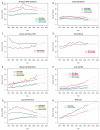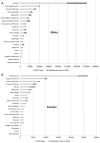The past, present, and future of cancer incidence in the United States: 1975 through 2020
- PMID: 25649671
- PMCID: PMC4507799
- DOI: 10.1002/cncr.29258
The past, present, and future of cancer incidence in the United States: 1975 through 2020
Abstract
Background: The overall age-standardized cancer incidence rate continues to decline whereas the number of cases diagnosed each year increases. Predicting cancer incidence can help to anticipate future resource needs, evaluate primary prevention strategies, and inform research.
Methods: Surveillance, Epidemiology, and End Results data were used to estimate the number of cancers (all sites) resulting from changes in population risk, age, and size. The authors projected to 2020 nationwide age-standardized incidence rates and cases (including the top 23 cancers).
Results: Since 1975, incident cases increased among white individuals, primarily caused by an aging white population, and among black individuals, primarily caused by an increasing black population. Between 2010 and 2020, it is expected that overall incidence rates (proxy for risk) will decrease slightly among black men and stabilize in other groups. By 2020, the authors predict annual cancer cases (all races, all sites) to increase among men by 24.1% (-3.2% risk and 27.3% age/growth) to >1 million cases, and by 20.6% among women (1.2% risk and 19.4% age/growth) to >900,000 cases. The largest increases are expected for melanoma (white individuals); cancers of the prostate, kidney, liver, and urinary bladder in males; and the lung, breast, uterus, and thyroid in females.
Conclusions: Overall, the authors predict cancer incidence rates/risk to stabilize for the majority of the population; however, they expect the number of cancer cases to increase by >20%. A greater emphasis on primary prevention and early detection is needed to counter the effect of an aging and growing population on the burden of cancer.
Keywords: cancer; cancer registries; incidence; predictions; projections; surveillance.
© 2015 American Cancer Society.
Figures




Comment in
-
Reply to it is not all black and white: Future incidence of stomach cancer will be substantially higher than projected due to the effects of immigration and increasing Hispanic and Asian populations in the United States.Cancer. 2015 Dec 1;121(23):4267-8. doi: 10.1002/cncr.29632. Epub 2015 Aug 17. Cancer. 2015. PMID: 26280155 Free PMC article. No abstract available.
-
It is not all black and white: Future incidence of stomach cancer will be substantially higher than projected due to the effects of immigration and increasing Hispanic and Asian populations in the United States.Cancer. 2015 Dec 1;121(23):4266-7. doi: 10.1002/cncr.29629. Epub 2015 Aug 17. Cancer. 2015. PMID: 26280930 No abstract available.
References
-
- US Cancer Statistics Working Group . United States Cancer Statistics: 1999-2010 Incidence and Mortality Web-based Report. US Department of Health and Human Services, Centers for Disease Control and Prevention, National Cancer Institute; Atlanta: 2013.
-
- Howlader N, Noone AM, Krapcho M, et al., editors. SEER Cancer Statistics Review, 1975-2010. National Cancer Institute; Bethesda, MD: [Accessed January 16, 2015]. 2013. Available at: http://seer.cancer.gov/archive/csr/1975_2010/
-
- Vincent GK, Velkoff VA. Current Population Reports P25-1138. US Census Bureau; Washington, DC: 2010. The Next Four Decades, The Older Population in the United States: 2010 to 2050.
-
- Smith BD, Smith GL, Hurria A, Hortobagyi GN, Buchholz TA. Future of cancer incidence in the United States: burdens upon an aging, changing nation. J Clin Oncol. 2009;27:2758–2765. - PubMed
MeSH terms
Grants and funding
LinkOut - more resources
Full Text Sources
Other Literature Sources
Miscellaneous

